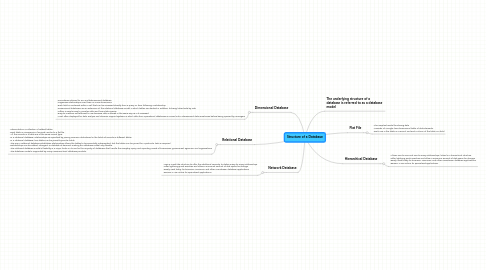Structure of a Database
by Kelly Shishko

1. Network Database
1.1. -Uses a mesh-like structure to offer the additional capacity to define many-to-many relationships -Offer lightning quick searches and utilize a minimum amount of disk space for storage -Rarely used today for business, consumer, and other mainstream database applications -Remain in use online for specialized applications
2. Relational Database
2.1. -Stores data in a collection of related tables -Each table is a sequence of records, similar to a flat file -All the records in a table are of the same record type. -In a relational database, relationships are specified by joining common data stored in the fields of records in different tables -In a relational database, two tables can be joined by similar fields -The way a relational database establishes relationships allows the tables to be essentially independent, but the tables can be joined for a particular task as required -Relationships can be added, changed, or deleted on demand, making this database model very flexible -The relational database model's flexibility is a major factor in its use for the majority of databases that handle the everyday query and reporting needs of businesses, government agencies, and organizations -The database model's supported by many consumer-level database products
3. Dimensional Database
3.1. -Sometimes referred to as a multidimensional database -Organizes relationships over three or more dimensions -Each field is contained within a cell that can be accessed directly from a query or from following a relationship -Dimensional databases are an extension of the relational database model in which tables are stacked in addition to being linked side by side -Offers a simpler way to visualize data and formulate queries -Easy to maintain and efficient to use because data is stored in the same way as is it reviewed -Most often deployed for data analysis and decision support systems in which data from operational databases is moved into a dimensional data warehouse before being queried by managers
4. Flat File
4.1. -The simplest model for storing data -Consists of a single, two-dimensional table of data elements -Each row in the table is a record, and each column of the table is a field
5. Hierarchical Database
5.1. -Allows one-to-one and one-to-many relationships, linked in a hierarchical structure -Offer lightning quick searches and utilize a minimum amount of disk space for storage -Rarely used today for business, consumer, and other mainstream database applications -Remain in use online for specialized applications
6. The underlying structure of a database is referred to as a database model


